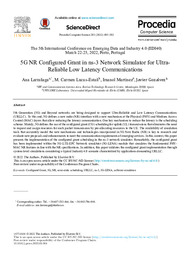Por favor, use este identificador para citar o enlazar este ítem:
https://hdl.handle.net/11000/26850Registro completo de metadatos
| Campo DC | Valor | Lengua/Idioma |
|---|---|---|
| dc.contributor.author | Larrañaga, Ana | - |
| dc.contributor.author | Lucas Estañ, María del Carmen | - |
| dc.contributor.author | Martinez, Imanol | - |
| dc.contributor.author | Gozalvez, Javier | - |
| dc.contributor.other | Departamentos de la UMH::Ingeniería de Comunicaciones | es_ES |
| dc.date.accessioned | 2022-05-04T12:40:20Z | - |
| dc.date.available | 2022-05-04T12:40:20Z | - |
| dc.date.created | 2022-04-27 | - |
| dc.identifier.citation | Procedia Computer Science, Volume 201, 2022 | es_ES |
| dc.identifier.issn | 1877-0509 | - |
| dc.identifier.uri | http://hdl.handle.net/11000/26850 | - |
| dc.description.abstract | 5th Generation (5G) and Beyond networks are being designed to support Ultra-Reliable and Low Latency Communications (URLLC). To this end, 5G defines a new radio (NR) interface with a new mechanism at the Physical (PHY) and Medium Access Control (MAC) layers that allow reducing the latency communication. One key mechanism to reduce the latency is the scheduling scheme. Mainly, 5G defines the use of the configured grant (CG) scheduling for uplink (UL) transmissions that eliminates the need to request and assign resources for each packet transmission by pre-allocating resources to the UE. The availability of simulation tools that accurately model the new mechanisms and technologies incorporated in 5G New Radio (NR) is key to research and evaluate new proposals and enhancements to meet the communication requirements of emerging services. In this context, this paper presents the implementation of the configured grant scheduling in the ns-3 network simulator. Remarkably, the configured grant has been implemented within the 5G-LTE-EPC Network simulAtor (5G-LENA) module that simulates the fundamental PHY-MAC NR features in line with the NR specifications. In addition, this paper validates the configured grant implementation through system-level simulations considering a typical Industry 4.0 scenario characterized by applications demanding URLLC. | es_ES |
| dc.format | application/pdf | es_ES |
| dc.format.extent | 8 | es_ES |
| dc.language.iso | eng | es_ES |
| dc.rights | info:eu-repo/semantics/openAccess | es_ES |
| dc.rights | Attribution-NonCommercial-NoDerivatives 4.0 Internacional | * |
| dc.rights.uri | http://creativecommons.org/licenses/by-nc-nd/4.0/ | * |
| dc.subject | Configured Grant | es_ES |
| dc.subject | NR | es_ES |
| dc.subject | 5G | es_ES |
| dc.subject | semi-static scheduling | es_ES |
| dc.subject | URLLC | es_ES |
| dc.subject | ns-3 | es_ES |
| dc.subject | 5G-LENA | es_ES |
| dc.subject.other | CDU::6 - Ciencias aplicadas::62 - Ingeniería. Tecnología::621 - Ingeniería mecánica en general. Tecnología nuclear. Electrotecnia. Maquinaria::621.3 - Ingeniería eléctrica. Electrotecnia. Telecomunicaciones | es_ES |
| dc.title | 5G NR Configured Grant in ns-3 Network Simulator for Ultra-Reliable Low Latency Communications | es_ES |
| dc.type | info:eu-repo/semantics/article | es_ES |
| dc.identifier.doi | 10.1016/j.procs.2022.03.064 | - |
| dc.relation.publisherversion | https://doi.org/10.1016/j.procs.2022.03.064 | - |

Ver/Abrir:
5GNR_CG_NS3_LarrañagaLucas.pdf
814,81 kB
Adobe PDF
Compartir:
 La licencia se describe como: Atribución-NonComercial-NoDerivada 4.0 Internacional.
La licencia se describe como: Atribución-NonComercial-NoDerivada 4.0 Internacional.
.png)